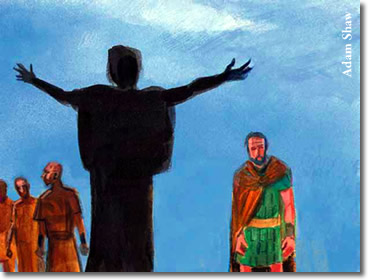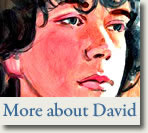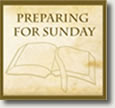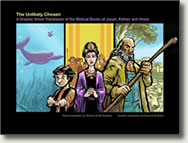Divining God's Will
 When Saul saw the army of the Philistines, he was afraid, and his heart trembled greatly. When Saul inquired of the Lord, the Lord did not answer him, not by dreams, or by Urim, or by prophets. —1 Samuel 28: 5-6
When Saul saw the army of the Philistines, he was afraid, and his heart trembled greatly. When Saul inquired of the Lord, the Lord did not answer him, not by dreams, or by Urim, or by prophets. —1 Samuel 28: 5-6
Have you ever been desperate for spiritual guidance, for some clue as to which way God would want you to go? What did you do? What methods did you employ? How did you attempt to forge a connection?
In the minds of the ancient Israelites, God’s preferences could be discerned through sacred objects and intermediaries. Some of these ancient intermediaries are familiar to us today, while others have been lost to history. Though the research is unclear as to the exact descriptions of the ephod, the Urim and the Thummim, we know that the former was a priestly garment worn under a breastplate. As for the Urim and Thummim, the Jewish Encyclopedia states, “The ancient, and most of the modern, explanations of these mysterious instruments through which Yhwh communicated His will to His chosen people identify them with (a) stones in the high priest's breastplate, (b) sacred dice, and (c) little images of Truth and Justice such as are found round the neck of the mummy of an Egyptian priest.” Whatever the particulars of their form and operation, we know that, for the ancient people of God, they functioned to determine divine direction.
Yet, in this account in 28th chapter of 1 Samuel, the spiritual tools Saul employs to discern God’s will are ineffective. Despite his multiple entreaties, he hears nothing from God. Neither the ephod, the Urim and Thummim, dreams nor prophets bring Saul the response he so desperately seeks. God seems to be sitting in stony silence as Saul tries every means available to elicit a reply.
For us, this story seems to point to the importance of intention and the danger of magical thinking. We too use spiritual tools to guide our prayers and steer us in the right direction. Whether we walk the labyrinth, study the enneagram, pray with beads or meditate using sacred icons, our tools are aides to help us worship and connect with God, open new avenues of interpretation, and focus deeply on sacred meaning. Yet our practices, like those of the ancients, are only effective as conduits for deeper exploration; their function is to point beyond themselves rather than become the object of our attention. The value of spiritual tools lies in their facility to help us move closer to the Holy by nurturing our relationship with God. If we place too much importance on the methods we use and the results we expect, we are confusing the vehicle with the destination.
In order to bridge the gap between belief and experience, between the head and the heart, between our Sunday pronouncements and our Monday ordinary life, we need to participate in the Divine life that is leading us from within and without. If we wish to get in touch with the authentic selves that God created and be true to the divine imprint on our souls, we need to look at specific, workable ways to get in sync with the process. In other words, how can we open ourselves to the guidance of God?
—Linda Douty
Getting From Sunday to Monday
To insist on a spiritual practice that served you in the past is to carry the raft on your back after you have crossed the river. —Siddhārtha Gautama
Now there are varieties of gifts, but the same Spirit; and there are varieties of services, but the same Lord; and there are varieties of activities, but it is the same God who activates all of them in everyone. —1 Corinthians 12: 4-6
Whether we remember them or not, we, too, have a number of dreams every night, each of them capable of giving us insight into ourselves and connecting us with the Divine. We don’t necessarily have to have an interpreter to profit from our dreams, but we do need to learn to pay attention to them.
—Susan Hanson
Learning from Dreams
John Donne said “As s/he that fears God hears nothing else, so, s/he that sees God sees every thing else.” Donne’s reference to fear reminds us of the need for spiritual tools to help clarify our fear-based emotions and thinking, one of the main obstacles to clear seeing.
Labyrinths fell out of use when we embraced the scientific paradigm that emphasized empirical methods and the rational mind. Relying on reason over intuition, we lost sight of these profound patterns that stir our spiritual nature and open deep capacities within us.
—Lauren Artress
Walking the Labyrinth
Answer me when I call, O God of my right! You gave me room when I was in distress. Be gracious to me, and hear my prayer. —Psalm 4: 1
Even if I don't want to say Morning Prayer, I feel its blessing before I'm halfway through the first psalm. The rule teaches me, over time: teaches me to expect delight from the good things I have included in the rule. And you usually find delight when you expect it.
—Barbara Cawthorne Crafton
A Rule of Life
"Spiritual practices help us move from identifying with the ego to identifying with the soul. Old age does that for you too. It spiritualizes people naturally." — Ram Dass
But the hour is coming, and is now here, when the true worshipers will worship the Father in spirit and truth, for the Father seeks such as these to worship him. — John 4:23



